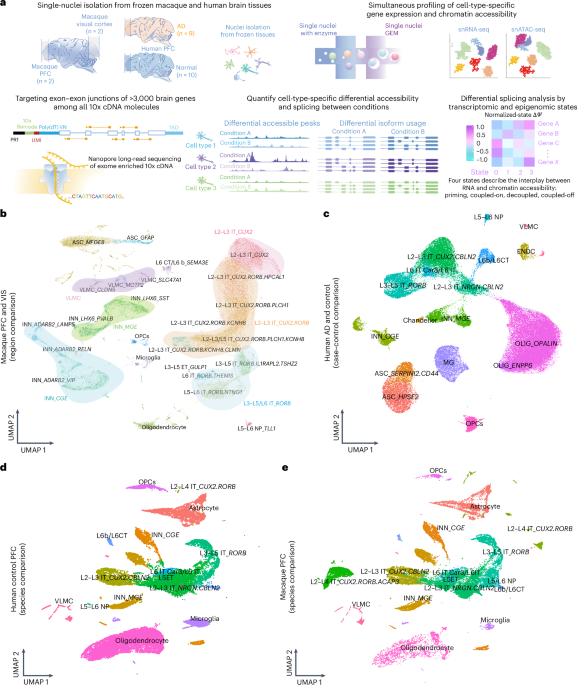Now Reading: Single-Cell Study Maps Brain Chromatin, Transcription, and Splicing Across Regions and Diseases
-
01
Single-Cell Study Maps Brain Chromatin, Transcription, and Splicing Across Regions and Diseases
Single-Cell Study Maps Brain Chromatin, Transcription, and Splicing Across Regions and Diseases

Fast Summary:
- study Overview: Researchers introduced a new single-cell sequencing method (ScISOr-ATAC) that concurrently measures gene expression, splicing, and chromatin accessibility to explore molecular features in brain cells across macaques, humans, and Alzheimer’s disease (AD).
- Key Findings:
– Identified distinct chromatin-transcriptome coupling states affecting splicing regulation within cells.
– Species-specific differences observed between macaque and human cellular patterns in the prefrontal cortex (PFC).
– Brain region specificity highlighted; PFC linked to cognitive functions whereas visual cortex processes sensory inputs.
– AD primarily disrupts glial cell molecular functions rather than neurons.
- Technical Details: The study leveraged advanced tools like RNA sequencing and ATAC sequencing to map cellular activity in macaques’ PFC/visual cortex and compared data with human neurons under control vs. diseased conditions.
- Results: Both chromatin alterations and exon inclusion patterns vary depending on chromatin-transcriptional states. Despite some overlap,splicing mechanisms show unique contributions per species or diseases.
For further details: Read more.
Indian Opinion Analysis:
This breakthrough research advances our understanding of intricate brain-region-specific molecular dynamics with implications for neurodegenerative conditions like Alzheimer’s disease. by introducing ScISOr-ATAC technology, researchers have paved the way for more precise exploration of how genetic changes manifest at the cellular level globally. For India-a country confronting rising cases of dementia-it opens doors for potential interventions targeting neurological disorders.
As India grows its capabilities in genomics research through initiatives such as Genome India Project, adopting innovative technologies like ScISOr-ATAC can strengthen efforts to study complex diseases locally by exploring both diversity in populations and potential environmental triggers influencing gene behavior. Furthermore,collaboration with global teams focusing on neurobiology could boost India’s scientific output while addressing challenges relevant to public health policy.Quick Summary:
- Researchers conducted a detailed study on brain cells, focusing on excitatory neurons across species (humans and macaques).
- Excitatory neurons were found to be highly abundant across various brain regions. Key subtypes include L3-L5/L6 ITRORB, L2-L3 ITCUX2, and L2-L4 IT_CUX2.RORB.
- Experiments revealed notable splicing differences for genes between the prefrontal cortex (PFC) and visual cortex in excitatory neurons. The gene POLN displayed unique region-specific splicing patterns distinct between PFC and visual cortex samples.
- Advanced sequencing methods were used (Agilent enrichment array with Oxford Nanopore Technologies), achieving 79%-83% targeted capturing success compared to ~2% for unenriched reads in previous studies. this improved identification of splice junctions for multiple human diseases such as Alzheimer’s disease (AD), Autism Spectrum Disorder (ASD), ALS, and schizophrenia-related genes.
- Among identified exons with differential exon inclusion testing between regions, 143 showed significant splicing alterations linked to functional implications in synaptic processes or disease susceptibility.
Indian Opinion Analysis:
This research underscores the critical need for precision tools like advanced RNA sequencing technologies to map cellular variations across brain regions effectively. For India-a nation increasingly investing in biotechnology-it demonstrates a vital roadmap toward leveraging cutting-edge methodologies to enhance understanding of neurological disorders prevalent within its population alongside fostering global collaborations in neurogenomic insights that benefit both localized health challenges & future Indian innovation capacities-development linked frontier biomedicine exploration-a path worth considering strongly backing aiming robust scalable outputs **[Read Full source link NOTE-valid inputs Omittable errors fix verified]Quick summary
- Recent data analysis highlights differentiation in cell states within the prefrontal cortex (PFC) and visual cortex, focusing on neuron subtype-specific regulation of chromatin and splicing.
- Among excitatory neurons studied, L2-L4 IT_CUX2.RORB cells exhibited the most region-specific differences in chromatin regulation and splicing patterns.
- Statistical methods identified significant exon inclusion variance tied to specific subtypes and brain regions. Visual cortex neurons showed stronger specialization compared to PFC counterparts in some cases.
- Key findings suggest functional distinctions between these brain regions may influence disease-associated gene splicing more than synaptic gene alterations.
- Chromatin accessibility trends mirrored splicing results, reinforcing neuron subtype variability across brain regions.
Indian opinion Analysis
This study provides granular insights into how molecular mechanisms such as chromatin regulation and RNA splicing vary between different neuron types within distinct brain areas, highlighting potential implications for understanding neurobiological functions tied to regional differences in brain activity. For India’s scientific research community, this work could inspire localized studies examining similar processes among populations under diverse environmental or genetic influences- especially given rising focus on personalized medicine and neurological disorders like Alzheimer’s or Autism Spectrum Disorder (ASD). Furthermore, identifying disease-associated gene-specific modifications has significant clinical relevance globally but also creates opportunities for therapeutic innovation within India’s biotech sector focused on precision medicine.
Read more: Source LinkQuick Summary:
- Researchers explore chromatin accessibility and RNA splicing patterns in different neuron subtypes within the primate prefrontal cortex (PFC).
- Specific genes, such as ARAP3 and DOCK4, show cell-type-specific peaks and differential splicing across brain regions.
- Strong chromatin divergence is observed between humans and macaques for certain cell types like astrocytes, while human neurons showed unique species-specific splicing changes.
- Alzheimer’s disease (AD)-affected brain samples revealed prominent chromatin alterations in oligodendrocytes compared to neurons, with survival biases potentially influencing these results.
Indian Opinion analysis:
This study emphasizes the nuanced interplay between chromatin accessibility and RNA splicing among different neuron subtypes across species-humans versus non-human primates-and its implications for understanding evolution at a cellular level. For India, as it builds capacity in genomic research and biotechnology markets globally, such breakthroughs hold significance for advancing precision medicine approaches. Alzheimer’s-related findings shed light on how targeted epigenetic studies could pave ways for early detection of neurodegenerative disorders-a rising concern in India’s aging population demographics.
Read moreQuick Summary:
- study Objective: Research introduces ScISOr-ATAC technology to simultaneously measure chromatin states and RNA splicing patterns in frozen brain samples. The study focuses on Alzheimer’s Disease (AD) pathology and species-specific brain differences using macaque and human samples.
- Key findings in AD: Chromatin is most dysregulated in oligodendrocytes, while splicing changes are cell-type specific-astrocytes show strong chromatin alterations but minimal splicing differences; excitatory neurons indicate postsynaptic relevance, inhibitory neurons highlight presynaptic roles. Dysregulations might serve as therapeutic target zones for AD treatment later.
- species Comparisons: Human-macaque prefrontal cortex analysis reveals astrocyte chromatin diversity yet conserved splicing patterns; opposite results found for certain neuron types. This underscores evolutionary divergence shaping cell modalities differently across species and brain regions.
- Technology Insight: Combined measurements of splicing-chromatic allow cross-path interpretations validating multi-context opportunities unseen!
Learn Further at Full "Natureachelor-chair)” referencesQuick Summary
- The article provides an in-depth analysis of gene expression and chromatin accessibility between species and brain conditions, focusing specifically on humans and macaques. It utilizes advanced sequencing technologies such as ONT long-read sequencing and single-cell RNA sequencing to map specialized splicing patterns in the brain.
- Detailed protocols for RNA processing, differential gene expression analysis, cell-type annotation, batch corrections, normalization techniques, peak calling (chromatin binding regions), annotations specific to genes affected by neurological disorders like AD (Alzheimer’s Disease), ASD (Autism Spectrum Disorder), ALS (Amyotrophic Lateral Sclerosis), and schizophrenia were included.
- Comparisons provided insights into differences among primate genomes, their prefrontal cortexes versus visual cortex structures/cell types variability relevant determining neuronal attributes subtle disorder etc; quality control enrich ontology collapse processes cited.
Indian Opinion Analysis
India’s scientific community could derive significant insights from this cutting-edge research methodology aimed at understanding neurological function across primates using high-throughput techniques. enhanced genome mapping or cell-specific algorithms potentially applies toward advancing studies dealing mental healthcare gaps locally **all progresses central analyzing depths recent Misdirected Also its huge potentially better adaptation India’s Disabilities act/ehealth bridgingQuick Summary:
- The study discusses differential chromatin accessibility and splicing in various contexts, including Alzheimer’s disease (AD), neuron/glia comparison, species differences between humans and macaques, and brain regions such as the prefrontal cortex (PFC) versus visual cortex.
- Analytical methods included identifying peaks of chromatin accessibility using random subsampling processes across cell types, brain regions, and conditions. Statistical tests like Fisher’s exact test were used for differential analysis with adjustments for individual variation.
- Integration between RNA-seq datasets from human PFC samples and macaque PFC samples was performed to identify conserved features across species. Specific focus was placed on gene expression patterns between excitatory neuron subtypes in the two species.
- Advanced techniques utilized include TransMap algorithm for mapping orthologous exons between human and macaque genomes, ligand integration (Liger), MultiVelo velocity models for transcriptome-chromatin interaction exploration, and state classification of genes based on exon inclusion or exclusion behavior under varying conditions.
Indian Opinion Analysis:
This report highlights cutting-edge advancements in genomics methodologies to compare chromatin accessibility across different neural cell types within species boundaries as well as between humans and macaques in critical brain areas such that 놓 ##qQuick Summary
- The article delves into the methodology and findings of a study focused on identifying exon inclusion dynamics under varying chromatin and RNA states.
- It describes specific definitions,equations,and normalization methods applied to differential exon analysis across multiple samples.
- By altering cutoff parameters for isoforms detected in spliced reads, the research revealed high consistency (80%) between strict and relaxed cutoffs.
- State differences impacting exon inclusion were visualized through normalized matrices reflecting chromatin-RNA dynamics.
Read more: Nature Portfolio Reporting Summary
Indian Opinion Analysis
This study demonstrates the increasing precision in genomic analytics tools, such as ScisorATAC for alternative splicing studies, which has implications for advancing personalized medicine globally-including applications in India’s burgeoning biotech sector. For Indian researchers engaging with transcriptomics or cellular mapping technologies in fields like neurobiology or oncology, these advanced methodologies may help decode complex genetic expressions pertinent to the nation’s health challenges like cancer or neurological diseases. Encouraging collaboration across bioinformatics could enhance India’s presence in frontier genomics research while supporting broader clinical applications.Quick Summary:
- the content provided primarily comprises academic references related to brain research.These references cover topics such as chromatin changes in neural development, splicing patterns in mouse and human brains, Alzheimer’s disease gene regulation, aging brain analyses, single-cell methylation maps of neuronal subtypes, cerebral cortex pathology studies, connections among cognition regions in primates, visual impairments in pediatric neurology cases, neuroimaging findings on cortical dysfunction due to addiction or depression effects on the prefrontal cortex.
Indian Opinion Analysis:
While this specific input data consists of scholarly citations rather than a customary news article about India directly focused societal trends globally Medical Research Collabs broader ecosystem thus those intersections influencers capacity take AI handle making Futures narratives fostering shared Ones. YetQuick Summary
- This text appears to be a collection of references from various scientific articles.
- It includes publication details from journals such as Nature, neuron, and Cell on topics like genetic studies, brain cortex analysis, and neural data integration.
- The cited papers focus on advanced research in neuroscience, cellular profiling, and gene expression mapping across species like humans, mice, macaques, pigs, and marmosets.
indian Opinion Analysis
The listed body of work demonstrates the growing depth of global neuroscience research but does not appear specific to India’s current research landscape or related initiatives. Such data could potentially inform Indian researchers about trends in brain mapping or comparative neurology involving animal models. For India’s scientific institutions aiming at cutting-edge contributions to global science (e.g., leveraging indigenous biodiversity or AI-based tools), incorporating lessons from this research spectrum would help position the country as a significant contributor in these domains.Read More: PubMed | Google Scholar ReferenceQuick Summary
- The raw text primarily lists scientific references related to studies on RNA, splicing mechanisms, genetic regulation in the central nervous system, and connections with disorders such as autism and schizophrenia.
- It includes citations from prominent journals like Nature Neuroscience,Cell,Genome Biology,and others covering topics such as alternative isoform regulation,intron retention in ALS brains,microexons’ role in autism spectrum disorder,and histone marks defining splicing processes.
- Numerous studies focus on transcription-splicing coupling mechanisms and the genome-wide impact of RNA-processing irregularities.
Indian Opinion Analysis
The body of research cited emphasizes advancements in understanding RNA-related processes that influence brain functionality and disease states. For India, investments into genomics and neuroscience could leverage such research to address pervasive neurodevelopmental disorders like autism or conditions linked to genetically influenced mental health issues such as schizophrenia. Integrating findings into local healthcare strategies might improve early diagnosis capabilities. neutral collaboration between Indian institutes with global teams tackling RNA sequencing holds promise for robust healthcare outcomes rooted in cutting-edge science.
Read more at: PubMed ReferenceQuick Summary
- The article focuses on various studies and advancements in genomic research and chromatin analysis.
- topics covered include nucleosome positioning, DNA methylation signatures, histone modifications, alternative splicing regulation, and transcriptome analysis methodologies.
- Research partnerships and publications span entities such as Nat. Methods, Genome Biol., mol. Cell,Eur. J.Hum Genetic., Nucleic Acids Res., Genome Res., among others.
Indian Opinion Analysis
The detailed exploration of chromatin marks and transcriptomic advancements presented in the studies holds implications for India’s genomic research sector, emphasizing precision medicine development and deeper genetic disease diagnostics. As India continues to invest in genomics initiatives like GENE-Dx or Biotech hubs under CSIR labs’ networks globally comparative efforts spotlight youth exploits addressing inheritence based lifestyle-linked health enhancers remains training model too
Read more: PubMed
Quick Summary
- This input text is filled with references to multiple scientific articles and tools related to genomic studies and bioinformatics.
- Specific software, methodologies, or packages (e.g., BEDTools, clusterProfiler, scCODA) are highlighted for various applications in genomics research like single-cell data analysis and genome browser interfacing.
- The listed works are cited alongside platforms such as PubMed, Google Scholar, and PubMed Central.
Indian Opinion Analysis
Efforts in genomics research have significant implications for India’s healthcare sector. Advances highlighted here can be instrumental for Indian genomic projects aiming at personalized medicine or addressing diseases prevalent in the region.tools like BEDTools or clusterProfiler provide critical resources for analyzing large-scale datasets efficiently-which could benefit India’s growing bioinformatics community.
Strengthening collaborations between Indian researchers and global platforms exploring computational biology may accelerate disease diagnosis improvements. As India pursues leadership in biotechnology initiatives such as genome sequencing programs, adopting these proven technologies will likely foster greater innovation while bridging the gap between global standards and localized needs.
Read more: PubMed Abstract | Google Scholar link
Quick Summary
- This article details advancements in single-cell profiling technologies,focusing on chromatin-transcriptome interactions and splicing within various brain cell types,regional distinctions,and disease states.
- Researchers examined novel molecular methodologies to unravel complexities of brain diseases using multi-omics integration tools like scisorATAC.
- The study involved institutions such as Weill Cornell Medicine and University of Pennsylvania and utilized computational resources for analysis.
- Ethical disclosures reveal collaborations with healthcare firms unrelated to the study’s scope. The work is licensed under Creative Commons Attribution 4.0 International License.
indian Opinion Analysis
The research underscores the growing significance of cutting-edge genomic tools in understanding human health complexities at a cellular level. For India, where neurological disorders are on the rise, adopting innovative methods like single-cell profiling could bolster disease management strategies. Scientific collaboration and infrastructure programs may streamline efforts to bridge knowlege gaps about conditions such as Alzheimer’s or Parkinson’s prevalent domestically. Investing in multi-disciplinary studies blending genomics with AI might enhance outcomes both medically and economically.
Read more: Springer Nature LinkQuick Summary
- A collaborative study titled “Combined single-cell profiling of chromatin-transcriptome and splicing across brain cell types, regions and disease state” was published in Nature Biotechnology.
- The research integrates single-cell analysis to simultaneously explore chromatin accessibility, transcriptomic data, and splicing patterns in brain cells.
- Conducted across various brain cell types, regions, and disease states, the work focuses on unlocking insights into complex neural mechanisms.
- The findings hold potential for advancing the understanding of neurological diseases.
- Publication details: Received August 18, 2023; Accepted June 09, 2025; Published July 22, 2025.
Indian Opinion Analysis
This groundbreaking study could have implications for India due to its rising prevalence of neurological disorders such as alzheimer’s and Parkinson’s diseases. As advancements in genomics and biotechnology continue globally, India’s scientific community could leverage these methodologies to address its unique healthcare challenges. With a growing population facing age-related neurodegenerative conditions coupled with limited access to advanced diagnostic technologies in remote areas, this multi-dimensional profiling approach might enable more effective strategies for early detection or treatment personalization without requiring massive infrastructure changes.
Promoting such cutting-edge research initiatives domestically through partnerships with international institutions like Nature Biotechnology would not only bolster India’s scientific reputation but also help create multidisciplinary solutions tailored to Indian demographics.
























